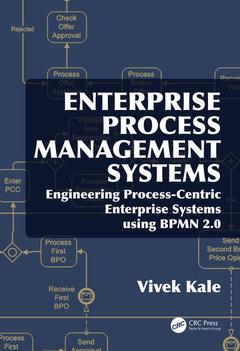Description
Enterprise Process Management Systems
Engineering Process-Centric Enterprise Systems using BPMN 2.0
Author: Kale Vivek
Language: English
Subjects for Enterprise Process Management Systems:
Keywords
Business Process; Enterprise Integration; Business Process Modeling Languages; Business Information System; Cycle Time; BPMS; Enterprise Systems; Business Activity Monitoring; Workflow Process Model; Business Process Reengineering Programs; Vice Versa; Bpm; Business Process Execution Language; Web Services Description Language; SOA; Enterprise Architecture; Sap Business; Flow Unit; MRP Ii; Virtual Machine; Business Process Modeling; Sap NetWeaver; Petri Nets; ERP System; Process-centric Applications; Workflow Engine; MRP System
Approximative price 196.56 €
In Print (Delivery period: 15 days).
Add to cart· 17.8x25.4 cm · Hardback
Description
/li>Contents
/li>Readership
/li>Biography
/li>
Enterprise Process Management Systems: Engineering Process-Centric Enterprise Systems using BPMN 2.0 proposes a process-centric paradigm to replace the traditional data-centric paradigm for Enterprise Systems (ES)--ES should be reengineered from the present data-centric enterprise architecture to process-centric process architecture to be called as Enterprise Process Management Systems (EPMS).
The real significance of business processes can be understood in the context of current heightened priority on digital transformation or digitalization of enterprises. Conceiving the roadmap to realize a digitalized enterprise via the business model innovation becomes amenable only from the process-centric view of the enterprise.
This pragmatic book:
- Introduces Enterprise Process Management Systems (EPMS) solutions that enable an agile enterprise.
- Describes distributed systems and Service Oriented Architecture (SOA) that paved the road to EPMS. Leverages SOA to explain the cloud-based realization of business processes in terms of Web Services.
- Describes how BPMN 2.0 addresses the requirements for agility by ensuring a seamless methodological path from process requirements modeling to execution and back (to enable process improvements).
- Presents the spreadsheet-driven Spreadsheeter Application Development (SAD) methodology for the design and development of process-centric application systems.
- Describes process improvement programs ranging right from disruptive programs like BPR to continuous improvement programs like lean, six sigma and TOC.
Enterprise Process Management Systems: Engineering Process-Centric Enterprise Systems using BPMN 2.0 describes how BPMN 2.0 can not only capture business requirements but it can also provide the backbone of the actual solution implementation. Thus, the same diagram prepared by the business analyst to describe the business?s desired To-Be process can also be used to automate the execution of that process on a modern process engine.
Enterprise Systems
Characteristics of Business Process
Systems Theory
Enterprise Architecture
Process Architecture
Enterprise Modeling
Distributed Systems
Service-Oriented Architecture (SOA)
Cloud Computing
Business Process Management
Business Process Model and Notation (BPMN)
Development of Process-centric Application Systems
Engineering of Process-centric Applications
EPMS for Business Process Analysis
EPMS for Business Process Reengineering
EPMS for Customer Conversations
Appendix A Business Process Execution Language (BPEL)
Appendix B Interaction Architectures
References
Index
Vivek Kale has more than two decades of professional IT experience during which he has handled and consulted on various aspects of enterprise-wide information modeling, enterprise architectures, business process re-design, and, e-business architectures. He has been Group CIO of Essar Group, the steel/oil & gas major of India, as well as Raymond Ltd., the textile & apparel major of India. He is a seasoned practitioner in digital transformation, facilitating business agility via process-centric enterprises and enhancing data-driven enterprise intelligence. He is the author of Guide to Cloud Computing for Business and Technology Managers: From Distributed Computing to Cloudware Applications, CRC Press (2015).




